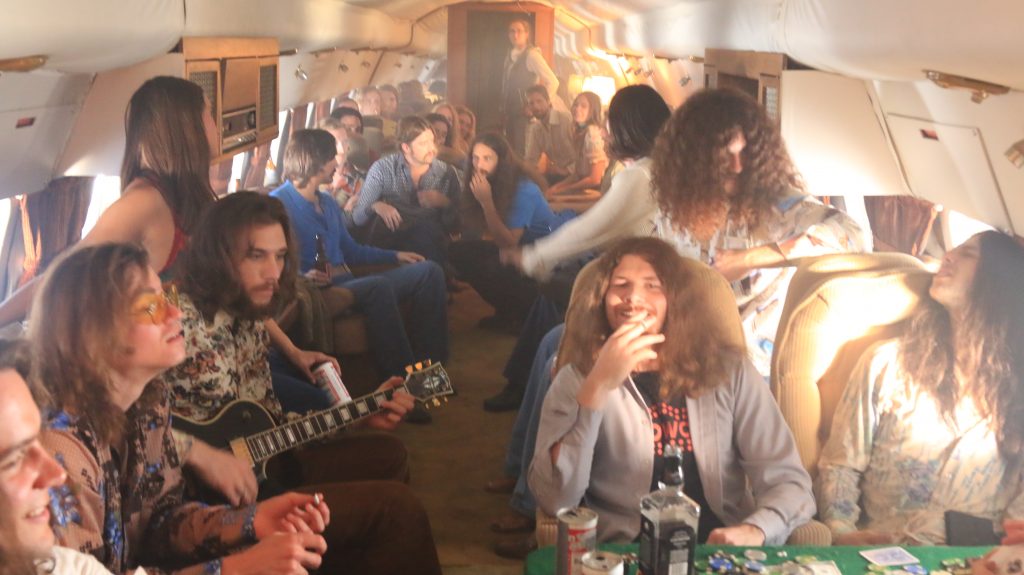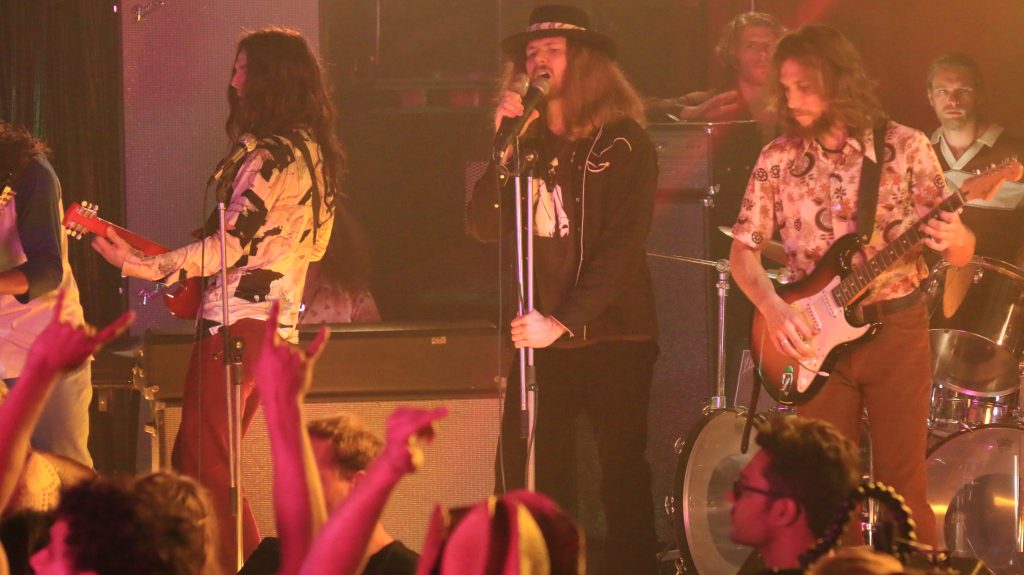July 1, 2020
by Carla Hay

“Street Survivors: The True Story of the Lynyrd Skynyrd Plane Crash”
Directed by Jared Cohn
Culture Representation: This dramatic film, which has a nearly all-white cast (with a few African Americans as extras), tells the story of the 1977 plane crash that took the lives of six people, including four people on the team of multiplatinum American rock band Lynyrd Skynyrd.
Culture Clash: Some members of the Lynyrd Skynyrd team had doubts and conflicts about the plane’s safety before it took that fateful flight.
Culture Audience: Lynyrd Skynyrd fans are the obvious target audience of “Street Survivors,” but the movie should also appeal to people who want to see a dramatic recreation of what happened before, during and after the plane crash, if they can stomach the very graphic and bloody scenes in the movie.

The tragic story of rock band Lynyrd Skynyrd has been told many times in news reports, feature articles, books and documentaries, including the 2018 documentary film “Lynyrd Skynyrd: If I Leave Here Tomorrow.” Most of these versions of the band’s story respectfully tiptoed around describing the explicit, gory details of what happened during and after the plane crash in 1977 that killed lead singer Ronnie Van Zant, guitarist Steve Gaines, backup singer Cassie Gaines (Steve’s older sister), assistant road manager Dean Kilpatrick, pilot Walter McCreary and co-pilot William Gray. The tragedy occurred because the faulty Convair CV-240 chartered plane ran out of fuel and crashed into a wooded area near Gillsburg, Mississippi, on October 20, 1977.
“Street Survivors: The True Story of the Lynyrd Skynyrd Plane Crash” (written and directed by Jared Cohn) does not sugarcoat or gloss over the horrors of the crash. The movie is so graphic with its up-close recreation of the blood, injuries and dead bodies, that this film is bound to disturb and probably anger a lot of people. Is it exploitation?
It would feel completely exploitative if not for that fact that plane-crash survivor Artimus Pyle, who was Lynyrd Skynyrd’s drummer at the time, approved this movie, because the story is told from his perspective. At various points of the film, Pyle does on-camera narration. As a survivor of this tragedy, Pyle certainly has the right to tell his version of events.
If a Lynyrd Skynyrd plane-crash movie had been made without any of the survivors’ input, it wouldn’t be right at all. But if a survivor, who saved the lives of several of the passengers, signed off on this movie, it’s up to viewers to decide if this dramatic recreation of the plane crash is something that’s worth seeing.
But sensitive viewers should be warned: This is one of the most graphic and disturbing plane-crash movies that you might ever see. It’s not recommended viewing for people who’ve survived an aircraft crash or who have a loved one who’s died in an aircraft crash, because this movie will no doubt be triggering for this type of trauma.
The plane crash is depicted about 50 minutes into this 92-minute film. Pyle opens the film by making this statement: “There have been many variations and accounts and contradictions to this story, but I was there. This was something that shouldn’t have happened, but it did. This is more than the story about the plane crash. It’s about the music of Lynyrd Skynyrd, the greatest Southern rock band of all time.”
Actually, the movie isn’t really about the music of Lynyrd Skynyrd, because very little of Lynyrd Skynyrd’s music is in the film. There’s a scene where the actors portraying the band are briefly shown performing Lynyrd Skynyrd’s cover version of J.J. Cale’s “Call Me the Breeze” on stage. The full performance of “Call Me the Breeze” (which is from Lynyrd Skynyrd’s second album “Second Helping,” released in 1974) is then shown during the end credits.
If people watching this movie are expecting to hear Lynyrd Skynyrd’s greatest hits, then they will be very disappointed. One can assume that this low-budget film didn’t have the money to license the rights to more Lynyrd Skynyrd songs and because there were legal disputes over this movie getting made. And that’s probably why the movie does not have a lot of scenes of Lynyrd Skynyrd recording songs or performing live.
And if people are looking for a “rise to fame” story of how Lynyrd Skynyrd went from being unknown musicians based in Tallahassee, Florida, to multiplatinum rock stars, the “Street Survivors” movie isn’t that story either. Because the “Street Survivors” movie is told from Pyle’s perspective, the film starts off with how he joined Lynyrd Skynyrd in 1975, shortly before Lynyrd Skynyrd recorded the band’s third album “Nuthin’ Fancy,” which yielded the hit single “Saturday Night Special.”
Pyle replaced original Lynyrd Skynyrd drummer Bob Burns, who quit the band after having a nervous breakdown. By the time Pyle joined Lynyrd Skynyrd, the band had sold millions of records and already had several hit songs, such as “Free Bird,” “Gimme Three Steps,” “Don’t Ask Me No Questions” and “Sweet Home Alabama.”
The “Street Survivors” movie shows how Pyle (played by Ian Shultis) got the call to audition for Lynyrd Skynyrd and how, about two weeks later, a jubilant Pyle was asked to join the band on stage in Atlanta. Patricia Williamson, who became Pyle’s first wife, is portrayed in the movie as a loving and supportive live-in partner. Williamson is played by Kristina St. Peter in a small supporting role.
After Pyle joined the band, Lynyrd Skynyrd released fourth album “Gimme Back My Bullets” in 1976, and fifth album “Street Survivors” in 1977, just three days before the plane crash. The “Street Survivors” album had the hit songs “What’s Your Name,” “You Got That Right” and “That Smell.” After showing Pyle joining the band, the “Street Survivors” movie skips right to 1977, with the band in the middle of a tour and partying heavily with groupies and other hangers-on at a hotel.
The other members of Lynyrd Skynyrd who are portrayed in the movie are lead singer Ronnie Van Zant (played by Taylor Clift), guitarist Gary Rossington (played by Navarone Garibaldi), guitarist Steve Gaines (played by Samuel Kay Forrest), guitarist Allen Collins (played by Rich Dally III), keyboardist Billy Powell (played by Hudson Long) and bass player Leon Wilkeson (played by Nick Chandler).
Also part of the Lynyrd Skynyrd team at the time were tour manager Ron Eckerman (played by Mark Dippolito), assistant tour manager Kilpatrick (played by Mark Valeriano), and backup singers Cassie Gaines (played by Lelia Symington), Leslie Hawkins (played by Sierra Intoccio) and JoJo Billingsley (played by Julie Zimmer). All of them and other members of the entourage were on that tragic plane flight, which had a total of 26 people on the plane.
The partying scenes in “Street Survivors” are what you would expect, considering the wild reputation that Lynyrd Skynyrd had in the 1970s. Drugs everywhere, especially cocaine and marijuana. Drunken antics. More than a few fist fights. Naked groupies offering up free sex.
In one scene, Van Zant throws a TV out of a hotel room window, causing the window to break in the process. A hotel manager angrily confronts the band in the room and tells them that they have to pay for the damages. Van Zant arrogantly asks the manager who’s going to make them pay, before bass player Wilkeson hits the manager on the head with a beer bottle.
The setbacks caused by this drug-and-alcohol-fueled lifestyle are referenced only in passing in the movie. For example, in another scene, Pyle answers a knock on his hotel door and is told by a male assistant, “Ronnie’s in jail, but here’s your gold record,” as Pyle is handed the gold plaque. It’s an example of the highs and lows of being in Lynyrd Skynyrd. Even before the plane crash, band members Van Zant, Rossington and Collins had car crashes, but those aren’t mentioned in the movie.
In one of his on-camera narrations, the real Pyle comments: “I want the world to know how funny my band was, because being the drummer of Lynyrd Skynyrd, every single day on the road was a hilarious adventure.” Therefore, it isn’t too surprising that the movie doesn’t really cover all the down sides of the band before the plane crash.
The only band members in the movie who are written as having distinct personalities are Pyle, Van Zant and Steve Gaines. All of them were heavy partiers, but Pyle is portrayed as the most responsible one of the three and perhaps the wackiest band member on stage. (Pyle would stage dive into the audience before stage diving became trendy.)
Van Zant is portrayed as a confident, outspoken leader with a quick temper but also extremely loyal to his bandmates. Van Zant had predicted to the other members of Lynyrd Skynyrd that he would die before the age of 30 (he was 29 when the plane crash happened), and that ominous premonition is recreated in the movie. Steve Gaines (who was 28 when he died) was the youngest and still fairly new to Lynyrd Skynyrd (he had only been in the band since 1976, as a replacement for Ed King), so he was the band member who was the newest to the rock-star/private-plane lifestyle that Lynyrd Skynyrd was leading.
Even though “Street Survivors” avoids covering the negative effects of the band’s hedonistic lifestyle, what the movie does show is how Lynyrd Skynyrd ended up with the faulty plane that caused this tragedy to happen. In one scene, Aerosmith’s then-manager David Krebs (played by Sean McNabb) is seen in his office, with all of the members of Aerosmith there, surrounded by cocaine and women.
Krebs is shown on the phone rejecting an offer for Aerosmith to use a chartered plane because the plane didn’t meet the band’s safety standards. He also yells at the person on the other line about how the airplane pilot was seen passing a bottle of Jack Daniel’s back and forth during the plane inspection.
Guess which plane Aerosmith rejected and ended up being used by Lynyrd Skynyrd? In the movie, when Lynyrd Skynyrd first sees the plane, someone utters, “What a piece of junk!” And someone else comments on the plane, “Well, I guess that must be ours.”
In the movie, pilot McCreary (played by Tom Jenkins) and co-pilot Gray (played by Will David Jordan) introduce themselves to the band and assorted team members on the airport tarmac. Gray is portrayed as a star-stuck fan who eagerly tells the assembled group: “All my life, all I’ve dreamed of doing is to fly a big rig with rock stars. After this, I’ll die a happy man.” Cringe.
And although the movie doesn’t portray the pilots as being under the influence of alcohol or drugs while flying the plane, it does portray the pilots as very reckless and dishonest about the plane’s mechanical malfunctions. The day before the tragic flight, Lynyrd Skynyrd flew on that plane and had a close call when one of the plane engines caught on fire. When asked about this major engine problem during the flight, co-pilot Gray brushed it off as “a little blowback” that was “normal.”
The movie shows that although several passengers on the plane were understandably freaked out by the experience, they decided to use the same plane the next day on October 20, 1977. According to the movie, the band’s tour manager made an angry phone call to fix the malfunctioning plane after they landed on October 19, 1977. Obviously, those repairs never happened.
After performing in Greenville, South Carolina, on October 19, 1977, the band had to fly to Baton Rouge, Louisiana, because Lynyrd Skynyrd was scheduled to do a concert at Louisiana State University on October 21, 1977. Because of the band’s tight schedule, there wasn’t enough time to charter another plane, and Lynyrd Skynyrd couldn’t risk missing the Baton Rouge concert by using other travel methods that would take longer.
Before he became a professional musician, Pyle was an aircraft sergeant in the Marines. That aircraft background helped when it became obvious the plane was in serious trouble during the flight on October 20, 1977. First, the engine problems started again, and oil from the engine could be seen leaking on the airplane windows.
Then, when Pyle and other passengers started asking the pilots what was going on, they found out to their horror that the airplane’s gas gauge wasn’t working, which gave the pilots an overestimation of how much fuel the plane had. The plane had actually run out of fuel. The crash happened when the pilots decided to make an emergency landing. The movie thoroughly conveys the panic that spread throughout the airplane when the passengers knew that they were going to crash.
The bloody and shocking aftermath of the crash is also portrayed in heart-pounding detail, including Pyle having to pull a heavy part of a tree out of a passenger’s chest. Pyle also joined forces with other survivors to try and rescue Rossington, whose legs were pinned underneath part of the destroyed plane. Pyle was the one who left the crash scene to get help in the remote area. When he finally saw a farmhouse and yelled for help at a man standing in the field, the man ended up shooting Pyle in the arm because he thought that Pyle was a crazy trespasser.
The hospital scenes are also very dramatic and might be very hard to watch for some people. The movie shows that even when Pyle was going through this trauma, he had to be the one to identify the bodies at the crash site. He was also the one who had to confirm who owned which luggage items at the crash site. And he had to go through the indignity of being interrogated by a Drug Enforcement Agency officer who was ready to arrest Pyle on the spot when DEA people found legal ginseng in Pyle’s luggage and mistook it for an illegal drug.
One of the points made in the movie is how MCA Records, Lynyrd Skynyrd’s record company at the time, refused to help pay the enormous hospital bills that resulted from the crash. Pyle was the crash survivor with some of the least-severe injuries, so he was the “go to” leading witness for what happened. (He was conscious the whole time and he was still able to walk immediately after the plane crash.) In the movie, Pyle is shown being presented with the hospital bills while many of the surviving passengers are still in the hospital.
Pyle makes an angry phone call to a record-label guy named “Pete,” who coldly tells Pyle that the company isn’t responsible for the hospital bills, because Pyle’s contract was with the now-dead Van Zant. Not for nothing, Lynyrd Skynyrd never released a new studio album with MCA again.
“Street Survivors,” the band’s last album with Ronnie Van Zant, had a haunting band photo on the cover, with fire in the background. In the photo, it looks like Steve Gaines is on fire, which is very eerie, considering that he died in a fiery plane crash. After the plane crash, MCA re-released the “Street Survivors” album with an alternate cover of a Lynyrd Skynyrd band photo without anything in the background. The album is still available with either album cover.
Although “Street Survivors: The True Story of the Lynyrd Skynyrd Plane Crash” doesn’t have top-notch acting or screenwriting, the casting for the movie is actually very good, since all of the actors resemble and capture some essence of their real-life counterparts. And the 1970s rock-star lifestyle scenes in the movie are very accurate.
However, the film’s direction and tone go back and forth between being hokey and suspenseful. Overall, it’s clear that the intention was to make Pyle look like the hero of the story. Some people will agree with that, while others won’t.
The movie has such a full-on commitment to showing realistic details of the plane crash that it might affect people on a deep emotional level. People will be really angry/sad that this tragedy happened or will feel very inspired by how Pyle handled this tragedy. There might be some people who feel both ways.
There will definitely be people who will hate this movie or feel lukewarm about it. However, it’s hard to imagine a lot of people loving this movie, because so much of it is disturbing to watch. Even if people think that “Street Survivors” is a good movie, they might have a hard time watching it again.
Cleopatra Entertainment released “Street Survivors: The True Story of the Lynyrd Skynyrd Plane Crash” on digital, VOD, DVD and Blu-ray on June 30, 2020.




